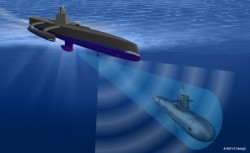Last week the U.S. government’s defense technology innovator, DARPA, awarded Science Applications International Corporation (SAIC) a $58M contract to develop the next phases of its Anti-Submarine Warfare (ASW) Continuous Trail Unmanned Vehicle (ACTUV) technology demonstrator. Besides a fine example of the DoD’s love of nested acronyms, the ACTUV program provides a peek into the promises and challenges of the future of unmanned ASW.
It’s important to note that note that the award is for a technology demonstration, not a program of record. The ACTUV will help the Navy mature technologies useful for future capabilities but is not expected to enter active fleet service itself. According to DARPA’s ACTUV website, the first, completed phase:
“refined and validated the system concept and associated performance metrics, completing risk reduction testing to inform program risks associated with submarine tracking sensors and maritime autonomy.”
SAIC is tasked with phases 2-4, specifically to “design a vessel (phase 2); build a vessel (phase 3) and test the vessel (phase 4). Operational prototype at-sea testing is expected in mid-2015.”
As stated in DARPA’s press release, the goal of the program is an “unmanned vessel that tracks quiet diesel electric submarines for months at a time spanning thousands of kilometers of ocean with minimal human input.” The website adds that an objective of generating a vessel design that “exceeds state-of-the art platform performance to provide complete propulsive overmatch against diesel electric submarines at a fraction of their size and cost.” In other words the vessel must be small and cheap (target cost goal of $20M apiece), yet robust enough to operate for 80 days and 6,200km without human maintainers or refueling.
The approach the program takes for propulsion will be interesting to see develop, as most long-range drone concepts have relied on solar panels or wave propulsion at the sacrifice of top speeds. Part of ACTUV’s endurance and speed will come from the drone’s design. According to navaldrones.com, the SAIC-built concept’s use a trimaran hull seen (see the video) offers better speeds over long ranges than traditional monohull designs. Additionally, going sans-crew frees up space normally devoted to crew-support systems to fill with more fuel tanks.

Hunting its prey, the ACTUV will have an edge during lower sea-state levels and due to the necessity of diesel electric subs to snorkel with regularity. High sea-states and advanced air-independent propulsion (AIP) diesel subs pose a greater challenge, although the former is mitigated by the lack of crew-safety requirements (no need to worry about the wardroom’s pitchers of kool-aid flying into SUPPO’s lap). As discussed in previous posts on our site, increasing a drone’s level of autonomy as DARPA intends with
the ACTUV – through “a sparse remote supervisory control model” – will decrease its susceptibility to hacking. However the need for two-way contact through communication and command protocols will still create vulnerabilities to guard against. The more the ACTUV communicates, especially in transmission, the more it increases the chance of being detected. In fact, although as a smaller vessel it might have a radar cross section akin to a pleasure craft or fishing vessel, its speed, sensor suite, and the simple fact that it’s a surface vessel will probably make it rather easy to detect – especially by the sub it is following. As a whole, this vessel will probably not be that stealthy, more often used in “we don’t care you know we know” type situations.
Automated responses also create the possibility of a dependable error that an enemy can exploit (think of a video game that freezes every time one particular action is performed). This is a more remote worry as the error would have to unknown or uncorrected by the U.S., be discovered by a foe, and be of practical tactical use (it doesn’t matter much if the ACTUV shuts down when trying to avoid whales if you can’t drive the ACTUV into a whale).
Another interesting requirement is the need for ACTUV to abide by maritime traffic conventions and legal restrictions. In practice this means preventing it from, say, running over a civilian on a jet ski or straying into protected marine habitats. But the day will come when some unmanned surface or subsurface vehicle does cause damage, and the legal and operational fallout will be quite interesting to watch.
Lastly, as noted in Aviation week, the ACTUV will not perform organic ASW search functions, but will instead rely on other ASW assets and intel to cue its tracking opportunities. Once acquired, the vessel will use “onboard acoustic, electro-optical, radar and lidar sensors to acquire and follow its submarine target.”
If it proves successful, the ultimate benefit of an ACTUV follow-on is therefore that it will free up more expensive assets to do other things. As configured, an engagement would require integration with a weapon-delivery platform, most practically an aircraft. However, like the predator, which made its debut as a strictly ISR platform, a future iterations could quite conceivably carry their own weapons. The ACTUV is a program to keep an eye on.
LT Scott Cheney-Peters is a surface warfare officer in the U.S. Navy Reserve and the former editor of Surface Warfare magazine. He is the founding director of the Center for International Maritime Security and holds a master’s degree in National Security and Strategic Studies from the U.S. Naval War College.
The opinions and views expressed in this post are his alone and are presented in his personal capacity. They do not necessarily represent the views of U.S. Department of Defense or the U.S. Navy.


3 thoughts on “Insights into Unmanned ASW”